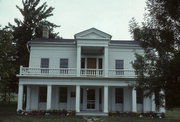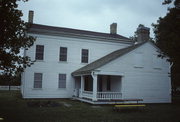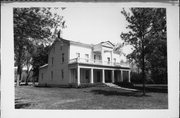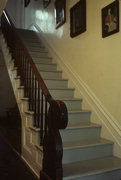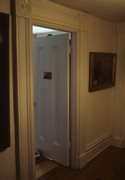Property Record
1313 AUGUSTINE ST
Architecture and History Inventory
| Historic Name: | Charles A. Grignon House |
|---|---|
| Other Name: | |
| Contributing: | |
| Reference Number: | 27254 |
| Location (Address): | 1313 AUGUSTINE ST |
|---|---|
| County: | Outagamie |
| City: | Kaukauna |
| Township/Village: | |
| Unincorporated Community: | |
| Town: | |
| Range: | |
| Direction: | |
| Section: | |
| Quarter Section: | |
| Quarter/Quarter Section: |
| Year Built: | 1837 |
|---|---|
| Additions: | |
| Survey Date: | 1993 |
| Historic Use: | house |
| Architectural Style: | Greek Revival |
| Structural System: | Balloon Frame |
| Wall Material: | Clapboard |
| Architect: | |
| Other Buildings On Site: | |
| Demolished?: | No |
| Demolished Date: |
| National/State Register Listing Name: | Grignon, Charles A., House |
|---|---|
| National Register Listing Date: | 10/18/1972 |
| State Register Listing Date: | 1/1/1989 |
| National Register Multiple Property Name: |
| Additional Information: | A 'site file' exists for this property. It contains additional information such as correspondence, newspaper clippings, or historical information. It is a public record and may be viewed in person at the State Historical Society, Division of Historic Preservation. HABS WI-28-13. The Grignon House, built c. 1836 by Charles Augustin Grignon, is a large 2 1/2 story Greek Revival frame house in the Federal mode. The main building has a one-story kitchen wing at the rear and, extending across the front, a "five bay, balustraded, square colonnaded porch, with a two story [pedimented] portico over the main entrance." This is the unique and outstanding exterior feature of the house, which is a handsome structure. The wing is now the kitchen but was originally the dining room. In the early days the kitchen was a separate building connected by a short covered passageway to the dining wing, where there was a window through which the food was passed. The original kitchen has long been gone, but the small window at the end of the wing still remains. The house has four fireplaces and seventeen rooms. Probably the most interesting interior feature is a solid cherry stair rail in the central hallway, with a fine, hand-carved, S-shaped newel post. It is in an excellent state of preservation. Once in near-ruinous condition, the Grignon House has been beautifully and faithfully restored, furnished with numerous original Grignon items and appropriate related pieces to the period of 1836, and is operated as a museum of early Wisconsin history. The Grignon House is located at the hub of early French activity in Wisconsin. It was built in 1836 by Charles A. Grignon, who was born at Kaukauna June 8, 1808, and died there April 18, 1862. Grignon was a great-grandson of Charles de Langlade (1729-1800) usually regarded as the first permanent white settler of Wisconsin. About 1745 Charles de Langlade, along with his father, Augustin, migrated to La Baye (Green Bay) from Canada. The father was an Indian trader of French extraction, and de Langlade's mother was the sister of the head chief of the Ottawas. A daughter of de Langlade married Pierre Grignon and the two men formed a partnership to establish a fur-trading post at Grand Caquillien Rapids (Kaukauna) before 1760. When Pierre Grignon died in 1795, the fur-trading post was taken over by his son, Augustin. Augustin married Nancy McCrea, a near neighbor whose family also was engaged in the fur-trade. Charles A. Grignon was their oldest son. Charles Grignon was educated partly in New York State and partly in Kaukauna. Upon completion of his studies he engaged in his father's enterpreises in Kaukauna and Green Bay, later formed a partnership in fur-trading with his brother, and was involved with businesses of his own. From August 25, 1830 until his death in 1862, he was United States interpreter at all the Menominee Indian Treaties. The Menominee are said to have refused to attend any meetings unless they had Charles Grignon as their interpreter and confidential adviser. In later years Grignon became involved in civic affairs and was Outagamie County treasurer for many years. The Grignon House, originally called the "Mansion in the Woods," was used as an inn, church, trading post, and meeting place for Indians. It was occupied by members of the Grignon family until 1933, when the youngest of Charles A. Grignon's children died there. The Grignon House leads us back to our earliest settlers and the beginnings of Wisconsin history. No other name in Wisconsin history is mentioned so often as that of the Grignons, and the index to the Wisconsin Historical Collections contains 1350 references to them. The architectural significance of the Grignon House is certified by the Historic American Buildings Survey. |
|---|---|
| Bibliographic References: | KAUKAUNA TIMES 7/21/1994. "Alderman Agree to 1996 Grignon Mansion funding." Historic American Buildings Survey, Wisconsin Architecture, National Park Service, Washington, D.C., 1965, 52. Perrin, Richard W.E., Historic Wisconsin Architecture, Wis. Chapter, A.I.A., Milwaukee, 1960, 29. Perrin, Richard W.E., Historic Wisconsin Buildings, Milwaukee Public Museum, 1962, 32, 37. "Grignon, Charles Augustin," Dictionary of Wisconsin Biography, State Historical Society of Wisconsin, Madison, 1960, 150, 151. "The Grignon House at Kaukauna," Badger History, 1(8):11, Madison, WIs., 1948. Appleton Post Crescent, p. A14, 6/1/1979. Appleton Post Crescent 5/14/2001. APPLETON POST CRESCENT. 6/1/1979. "Indian Lore Comes to Grignon Home." KAUKAUNA TIMES. 1/4/1989. "Restoration, larger Events Planned as Grignon Mansion." Plan for proposed restoration by the Outagamie County Historical Society, Inc. "The Charles A. Grignon Mansion Restoration 1989-1994." Perrin, Richard W. E., Historic Wisconsin Architecture, First Revised Edition (Milwaukee, 1976). Walking Tour Through Old Kaukauna: Two Self-Guided Historic Tours Kaukauna, Wisconsin, City of Kaukauna, 1983. |
| Wisconsin Architecture and History Inventory, State Historic Preservation Office, Wisconsin Historical Society, Madison, Wisconsin |

